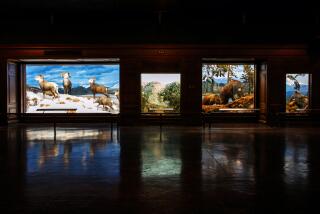Where art and information intersect
- Share via
London — Design is about finding elegant solutions to managing our stay on earth, the spaces we inhabit and the paths we take around the world. And contemplating the free-for-all of ideas and inventions represented in the Design Museum’s new exhibition “You are Here -- The Design of Information” is an interesting study for those struggling to visualize solutions to managing their own everyday environments.
How does one configure a tiny kitchen, arrange the artwork on the walls, devise a home-office filing system or design the dream house? One ingenious step at a time.
This show catalogs some of the ways in which people over the last few centuries have mapped out and reimagined their universe -- making it easier to visualize, comprehend and navigate. A stroll through it is a useful exercise for those in search of inspired problem-solving and far-ranging ideas.
When you enter the suite of rooms that make up this modest but compelling exhibition, chirping bird-song used in Japanese subways to guide the blind toward station exits fills the air. Harry Beck’s London tube map from 1933, which sacrifices a representational view of the city to make its underground comprehensible, takes on the allure of a treasure map. The elusive is captured artfully in an 1820s cloud study from John Constable.
And perhaps the most intriguing interpretation of Shakespeare to date is a print of beautifully abstract, multicolored swirls that make up Fang Leo’s 2004 color-coded map of emotional states in “Macbeth.”
Much of this exhibition has to do with the ways in which human beings have made it easier to move from one place to another. But the clever German-produced “Point It” traveler’s guide -- a featherweight, pocket-sized book featuring photographs of cameras, toilets, socks and other essentials -- solves the problem of what we do once we find ourselves in a country without its language. Comparative road signs from various countries hang next to a timesaving Japanese carriage guide from 2004 that shows passengers where to sit on the train in order to get out nearest their exits upon arrival.
We learn that the now ubiquitous London A-Z street guide was self-published in 1935 by a writer-painter named Phyllis Pearsall, who was tired of getting lost and pounded the city’s pavement making sure she, or the rest of the world, never did again. Similarly, in 1998, a man named John Sims published an upside-down road map of the United Kingdom to help himself (and others) navigate their way south from trips to Scotland.
An Iraqi combat bandage from the Gulf War is printed with diagrams of soldiers, demonstrating how to tie it to accommodate various wounds. An 1889 poverty map of London is juxtaposed with a computerized “noise map” of the city from 2004. A phrenological chart from 1845 charmingly illustrates the parts of the brain devoted to “marvelousness,” “mirthfulness” and other such states.
Who knew that Florence Nightingale, not some anonymous math geek, was the pioneer of the pie chart, which she dreamed up to illustrate the causes of Crimean War deaths for government ministers whose imaginations were unmoved by a typewritten report? The pie charts showed in a graphic and incontrovertible instant that British soldiers were not largely dying of battle wounds but of disease brought on by substandard living conditions.
Curator James Peto points out that good design is something we take for granted.
“Most of us don’t think of information and design in the same sentence,” he says. “Or we think of rather dull things like computers and railway tables. But a lot of interesting and unlikely people have worked in the field, like Buckminster Fuller and Florence Nightingale -- driven out of necessity or a crusading desire to improve people’s understanding of the world. The attempt to boil things down into something practical and useful and attractive as well, that’s what I find really interesting. It’s limitless.”
“You Are Here” at the Design Museum in London until May 15. www.designmuseum.org.
More to Read
The biggest entertainment stories
Get our big stories about Hollywood, film, television, music, arts, culture and more right in your inbox as soon as they publish.
You may occasionally receive promotional content from the Los Angeles Times.










